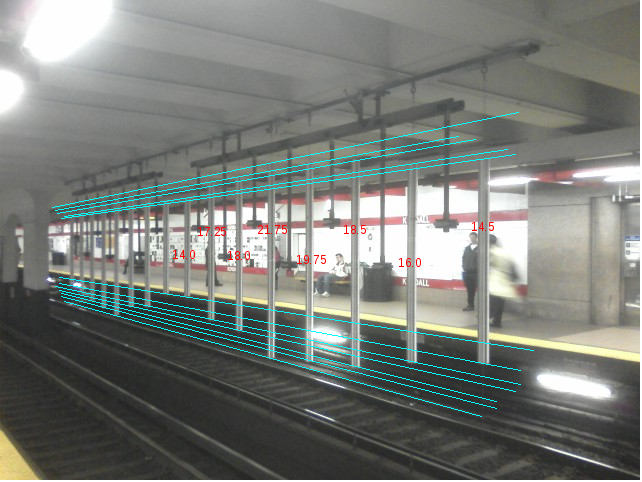kendall band and stiff resonator physics
The Kendall Band at the subway station on campus had been rusting away, with only the chimes — the part they call “Pythagoras” — working. The other parts, “Kepler” and “Galileo” I have never seen working in all the years I have been here. Then one day “Pythagoras” too was gone for repairs. They posted this note for half a year until suddenly, it was back!

“Pythagoras” is two identical sets of eight pipes that could be struck by seven different mallets each. The mallets are controlled by a bar that could be swung back and forth by an attached handle which the user controls on the platform. Before the repairs, I had never paid attention to its intricacies, partly because there was not much time to play with them in the time before the next train arrived, and partly because the old rusty version didn’t make great sounds and I thought they were just some randomly sized pipes. Plus, the handle lacked fine control, and the best one could do was to hopefully transfer as much energy as possible to even get the thing going.
When it came back new, it was looking much like a real instrument and now I wondered what else you could do with it besides swinging the handle back and forth like most people do. Surely you could play an actual melody, right?
Granted, I don’t think that was even an intent by the designer, as the mallet lengths are somewhat too similar. I even thought there were only two lengths, long and short, but upon closer inspection each mallet does have a unique length. So a little signal processing thought came to me that swinging the handle a certain way should allow individual pipes to be struck at designated times. So far I’ve only successfully separated the swinging of long and short mallet sets; that one is easy: they respond to two fairly different oscillating frequencies.
What really bothered me though was not knowing what notes were played by the pipes. It’s always hard to tell since multiple pipes are struck and then other multiple pipes are struck soon after, then the train comes and people talk. But I had some ideas… there was clearly a minor chord and a major chord in there, and nothing sounded chromatic. One day I took a photo of the installation thinking how hard could it be to figure out the frequencies from the pipe lengths…

So glad that the two sets of pipes are identical so I could correctly draw perspective lines, and roughly measuring the lengths with some arbitrary units I get: 14.0, 17.25, 18.0, 21.75, 19.75, 18.5, 16.0, and 14.5. Yet doing \(12 \log(L_0 / \mathbf{L}) / \log(2)\) gives consecutive oddball fractional intervals in the quartertone range and no way at all to reconcile with the diatonic scale even considering rounding error.
Turns out pipes are “metallophones,” and there is no column of resonating air inside like in “aerophones” such as organs, woodwinds, and brasses. Indeed, the timbre is different and the metal pipe itself bends back and forth to make sound. Fine, so it should be closer to struck and plucked strings, but those too have frequencies \(\propto 1/L\), what gives? So I looked up this book* referenced in this paper and it says that metal pipes (and also stiff plates and stiff strings) have completely different physics than the more familiar tensioned strings, the restoring forces being internal elasticity and shear, some kind of fourth-order differential equation results that makes frequencies \(\propto 1/L^2\).† Ok, I didn’t even know there was this third class of resonant behavior.
Now things could fall into place. Doing \(12 \log(L_0^2 / \mathbf{L}^2) / \log(2)\) gives: -6.55, -3.21, -0.95, 0, 1.47, 4.08, 7.49, 8.70 once the pipe lengths are sorted from long to short. There would be a plausible fit to the diatonic scale, if these semitones are rounded this way: -7, -3, -1, 0, 2, 4, 7, 9. The pipes are actually arranged like 9, 2, 0, -7, -3, -1, 4, 7, so the even and odd pipes (as the mallets swing back and forth between them) would indeed make major and minor chords, if only the fourth pipe were not a -7, but a -5 (the next closest rounding). So I went back to the station to listen to just the fourth pipe (hard to do), and I just don’t hear a -7, in fact, I hear a -5, so there is probably an unfortunate measurement error in the lengths of the longest two pipes. But correcting for that first interval, and taking into account the highest note sounds like B3 (easy to hear), the eight pipes probably sound the notes: B3 E3 D3 A2 B2 C♯3 F♯3 A3, and this result I actually believe.
* Fletcher and Rossing, The Physics of Musical Instruments, page 58.
† \(\frac{d^4Y}{dx^4} = \frac{\rho \omega^2}{EK^4} Y = \frac{\omega^4}{v^4} Y\) where \(v^2 = \omega K \sqrt{E/\rho}\). I think \(E\) is Young’s modulus or something and \(\rho\) is material density, \(\omega\) is radian frequency, and \(K\) is the radius of gyration (an RMS radius over a cross section, basically). \(Y\) is the phasor of the transverse displacement. Apparently the solution is: \(y(x, t) = \cos(\omega t + \phi) [A \cosh kx + B \sinh kx + C \cos kx + D \sin kx]\). For a bar free at both ends (our case), allowed frequency “modes” are: \(f_n \approx \frac{\pi K}{8L^2} \sqrt{E/\rho} (2n+1)\), where \(n=1,2,…\).
 Comments(1)
Comments(1)
[...] more than 1 year — judging by this post — the Alewife bound part of Pythagoras is still broken. Up till a few months ago the graffiti [...]